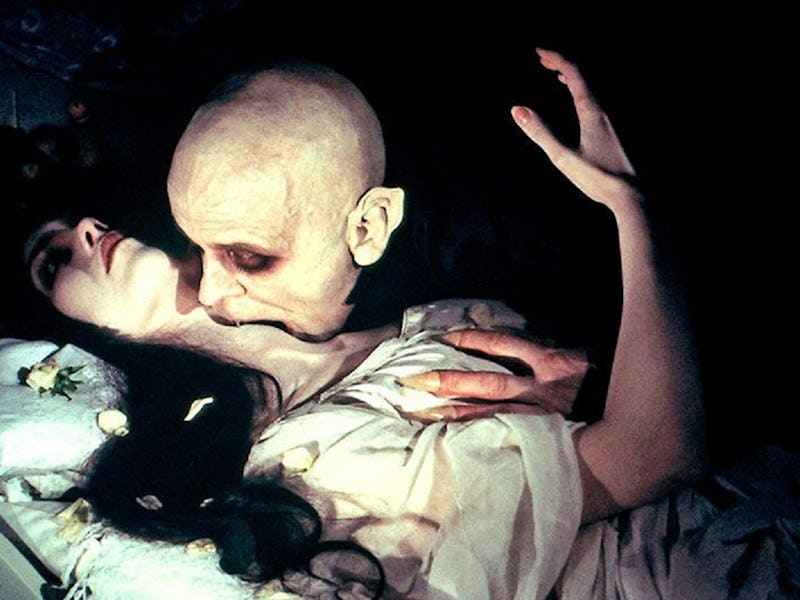Before Robert Eggers, Werner Herzog Put His Own Surreal Stamp on Nosferatu
There’s an important lesson to be found in Nosferatu the Vampyre.

More than a century after the 1922 German film Nosferatu cast a shadow over horror cinema, a new remake is coming from director Robert Eggers (The Witch, The Lighthouse). But Eggers’ upcoming film won’t just have to measure up to the original. That’s because 45 years ago today, a famously existential German film director teamed up again with one of the most volatile actors at the time to make 1979’s Nosferatu the Vampyre, a striking remake that stands today as Werner Herzog’s only entry into the horror canon. But what an entry it is.
The film, perhaps with the benefit of public domain, dispenses with the original film’s Dracula stand-in of Count Orlok altogether. Herzog’s friend and mortal enemy Klaus Kinski — their infamous relationship perfectly captured in the film My Best Fiend — plays Dracula, while Bruno Ganz plays Jonathan Harker (“Thomas Hutter” in the ‘20s version). Isabelle Adjani, who today is iconic enough in horror for her turn in the classic Possession, anchors the film as Lucy Harker, Jonathan’s wife.
In the beginning of the film, despite every possible warning, Jonathan Harker goes to the castle of Count Dracula. He’s been sent there by Renfield, Dracula’s devoted servant, to complete a real estate deal. Of course, no one in a horror film simply trots out of Dracula’s castle unperturbed. No, Jonathan is on his road to vampirism, just as Dracula is on his way to Wismar, with rats in tow to destroy the city by plague. The only one who can stop him is Lucy, who can’t get local scientist Abraham Van Helsing to believe her.
The film is quite a break from the Dracula novel, following the 1922 film more closely. Lucy in the original novel isn’t married to Jonathan, and is instead the best friend of Jonathan’s wife, Mina. Van Helsing takes the lead in vampire hunting in the novel, but is a skeptic in the movie.
But even as a remake, the film is very much its own thing. The horror doesn’t come from jump scares, but from dread, decay, and surreal images, which makes it … basically your average Werner Herzog film, just turned up a few notches. There’s a creeping sense of inevitability to the plot, and as things get worse in Wismar, that feeling becomes tangible in every movement of the film.
Lucy is an even more tragic figure in this film, not helped by some of the gaslighting she receives (including from Van Helsing) for believing that something is wrong — and this is as the streets are literally robbed of life while a new plague takes hold, thanks to countless rats. (Seriously, Herzog may have had to film a town over because Wismar wasn’t keen on the director bringing in more than 10,000 rats for the film.)
Using the names and premise from Bram Stoker’s Dracula, but the plot of the original Nosferatu, Herzog’s remake is a strange and fascinating beast.
While we’ve grown used to the term “elevated horror” in the A24 age, Herzog’s Nosferatu came out at a time when horror movies were serious business, as artful as they were terrifying. Dario Argento was his second film into an incredible run when Suspiria came out in 1977, and that same year saw the release of Lucio Fulci’s The Psychic and David Lynch’s Eraserhead; George A. Romero (with some help from Argento) had unleashed maybe one of the best sequels of all time in 1978 with Dawn of the Dead; Ridley Scott’s Alien was about to change two genres for the better a few months after Nosferatu; Stanley Kubrick’s then-divisive The Shining came out in 1980; and Possession would arrive in 1981.
These aren’t just tentpoles of the genre — they’re lyrical, intelligent, well-crafted horror movies that dispense with convention and are as visually stunning as they are scary. That Herzog’s only horror outing fits so seamlessly is a testament to his talent. But it’s also a testament to the talents of Kinski and Adjani, in particular, who have a particular anti-chemistry that gives the film’s climax a creepily effective staying power.
Lucy is even more of a tragic victim in this remake.
Kinski seems otherworldly as Dracula. There’s never a pretense of Bela Lugosi-ish charm to his portrayal. He has a menacing, monstrous presence from the start, making his ascent all the more dreadful. And Adjani, with piercing eyes, brings an emotional core to the film. Ganz, of course, is no slouch here, and his quest and downfall incorporate elements of the story of Mina Harker from the original novel.
People complain today, often correctly, that there aren’t a lot of original ideas, and that most movies are franchises, reboots, and remakes. But maybe there’s an essential lesson to follow in the 1979 Nosferatu, of taking command of a vision, and honoring the source material while making contributions that build on its legacy while establishing a new one. If Eggers’ upcoming film falters — which I’m not banking on, considering the director’s track record — it may be because it doesn’t follow the blueprint Herzog set for him: to do something bold, strange, and just … different.